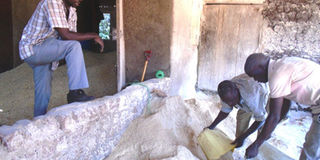How Musoke mills cash from maize

Joseph Musoke, left, looks on as workers pack maize bran in a bag. PHOTO Fred Muzaale
What you need to know:
Joseph Musoke started by earning as little as Shs250 per kilogramme selling unprocessed maize grains. Thanks to value addition, today, Musoke pockets Shs1500 per kilogramme, writes Fred Muzaale.
Maize is grown in many parts of Uganda, both as a food and cash crop. Because of the increased demand for maize by-products and flour for consumption, maize growing is now rewarding.
However, many farmers after harvesting their maize, sell dry grains to middlemen who pay them little money.
The middlemen in turn make a big profit margin from the maize by just milling and selling it as maize flour.
Unlike such farmers, Joseph Musoke, 45, a resident of Nakifuma in Mukono District has discovered gold in adding value to his maize.
Starting
Musoke says six years ago, he discovered that he could earn more from his maize by milling it into maize flour.
“I had grown maize for over nine years and I was selling grains to businessmen who paid me little money. After sometime, I realised that these businessmen were making more profits than I did by simply milling the maize,” Musoke says adding “I had to stop selling the grains and reverted to selling flour.”
In 2009, Musoke planted two acres of maize from which he harvested 3,200 kilogrammes of maize.
He says by then, a kilogramme of maize grain was going for Shs250 so by selling it in grain form he would earn about Shs800,000.
However, when he milled it he got 2200 kilogrammes of flour and sold each at Shs1,400 thus getting about Sh3m. However, Musoke explains, when he subtracted all the costs such as milling and transport, he remained with about Shs2.5m. So he earned about Shs2m more.
Since then, he says, he has realised that adding value to maize brings more profits, thus, Musoke has never again sold his maize in grain form.
The farmer and businessman says that currently, he has milled 5,000 kilogrammes of maize flour, all from his garden. Due to the moderate supply of maize grains on the market owing to the fair rains that were received throughout last year, he says the price for a kilogramme of maize grain is now at Shs650 from Shs850 at which it was last year.
Process
•He harvests the maize when it is dry and threshes it using a
maize thresher.
“The maize from the garden is high quality and i harvest it only when dry,” says Musoke.
•The grains are then dried on tarpaulins to ensure that they
do not get soiled.
“Tarpaulins are perfect but if you do not have one you can use mats made of reeds,” Musoke advises.
•The maize is then sieved to remove the chaff from grains.
“When proper or 100 per cent dry make sure you sieve the grains from any foreign element such as stones and feathers,” he says.
•It is then taken to the maize mill where it is milled according to
the required grade.
•It is then packed in bags of 10 kilogramme or 50 kilogramme.
Impact
“The elections in neighbouring Kenya and the insecurity in south Sudan, which import a lot of the maize from Uganda have impacted negatively on my side as the demand for maize is relatively, low something that has led to the prices not to go up,” he explains. Nonetheless, Musoke explains that the current price is fair since during times when there is high supply of maize grains on the market, the price falls to Shs300 or even less. He says 2015 was his best year ever since he started growing maize as he milled and sold a kilogramme of maize flour at Shs3,500. This was because there was acute shortage of maize on the market due to the prolonged drought that year.
Currently, he sells his flour at a retail price of Shs1,500 for number one (grade one), which is the best grade while grade two is at Shs1,200. Because of the relatively low prices of flour, Musoke says both grades are on high demand. But with prospects that the prices of flour might increase early next month when schools re-open, Musoke says he is going to store some of his flour until the prices go up. This season he says he expects to earn about Shs12m from his 8,000 kilogrammes of maize flour he has in store.
Did you know
Corn is called maize by most countries, this comes from the Spanish word ‘maiz’. Corn is a cereal crop that is part of the grass family. An ear or cob of corn is actually part of the flower and an individual kernel is a seed. On average an ear of corn has 800 kernels in 16 rows. Juices and soft drinks like Coca-Cola and Pepsi contain corn sweeteners.
Packaging
When the maize mill process maize grains, it will come out with different final products such as flour, grits which are different from their granular size. The other product is the maize bran. For the packing, farmers must adopt full-auto flour. The flour is then packed into 5kilogramme,10kilogramme,25kilogramme or50 kilogramme.
Value addition advantages
Besides, higher profit margin he gets when he mills maize, Musoke says he also gets maize bran, which he sells to poultry and piggery farmers.
“Maize bran is very profitable. Even before milling I have orders from farmers who book in advance,” says Musoke.
Currently, a kilogramme of maize bran goes for Shs650.
Musoke adds that milling maize eliminates the middlemen who were cheating him and other farmers and in turn he makes more profits than them who toil to grow the maize.
Challenges
The biggest challenge he faces is the high milling costs as a result of high electricity costs.
Currently, they charge him Shs200 for milling a kilogramme of grade one maize flour from Shs150 while number one and a half is milled at Shs150 per kilogramme.
The high milling costs reduce his profit margin, he says.
Since he sometimes also buys from other farmers he is affected by the high cost of maize grains.
Also, the long dry spells lead to crop failure since he depends on rain to grow his crop.
Market
He sells his produce to schools and other institutions plus produce stores in urban centres such as Kampala, Mukono, Kampala, Entebbe, Luwero, Masaka and others.
Musoke also sells to individual buyers. He says he sometimes take the flour to the buyers, who occasionally pay him cash or pay after sometime. When schools are open, is Musoke’s best time for his business. In a week he sells between 40-50 bags of flour.




